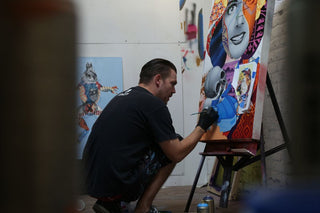Whether he accepts the accolade or not, Tristan Eaton is a legend in the making. At still a few years shy of 40, the Los Angeles-born artist has already achieved the pinnacle of what many fine art and graffiti-influenced forefathers often spend a lifetime attempting to balance—public visibility, respect from the streets, and recognition from the contemporary art world. Tristan has walked an incredible line. Some of his art resides in permanent collection at the MoMA, while other commissioned or self-propelled mural work graces walls from as far away as Mexico to as close to home as Detroit, New York City, and Downtown LA.
When I spoke to the artist in December, he was preparing to participate in Art Basel 2015. I congratulated him on achieving what I dubbed the “holy grail” of career momentum. He had just exhibited a breakthrough solo show, “Legacy,” earlier in November and was preparing to shine some more. His response to my praise was, “Getting it is one thing. Keeping it is the hard part.”
Tristan has artistically done it all—magazines, toy companies, his own creative agency, you name it. The latest chapter in his own legacy, however, is a calling that’s brought his art back home to California, where he’s confronted the entirely new purpose of documenting his own family’s history. The challenge inspired last November’s solo exhibition, “Legacy,” and much of how he currently manifests his incredibly-detailed, layered, and signature collage stye of aerosol art. Eaton’s work is comic-slash-history books on acid at the swankiest dinner party ever. It’s that colorful, immersive, informative, and organized. It’s an incredibly lush time machine for the eyes, full of subversive, pop, and wildly vivid illustration elements—no doubt the result of his enthralling artistic track record and some really important graffiti world mentorship.

Photo: Library Street Collective & Subliminal Projects
RAINEY CRUZ: Tell me about your “Legacy” show and what inspired it.
TRISTAN EATON: The family crest that I obtained from my dad has the words “Truth Conquers All” on it. That’s tattooed on my arm. Like that tattoo, that exhibition was an homage to my father in a very roundabout way. In his passing, I felt like there wasn’t enough there for his legacy or future generations.
A lot of the show was telling his story by telling the stories of the people he loved. One of his hobbies was sitting down with people and sharing their life stories. He loved people genuinely and would sit for hours with them and ask them questions. He knew how rare that was and how it could make someone feel, that someone else cared that much about them. It was such a generous act that I picked up the hobby too, in order to walk in those shoes a bit. I then used that interviewing technique in order to find inspiration to paint these portraits of the people that he loved.
“[Legacy] was by far the hardest and best exhibition that I’ve done in my life.”
Those people are pretty interesting in their own way and the next thing I know, I’m recording stories about someone winning an Oscar, someone being shot three times, someone marching in the “I Have a Dream” Martin Luther King march. All of these miraculous stories that have happened over the last 60 years. Those stories became really interesting in their own way. The original intent was for them to become a time capsule. For those audio conversations to be recorded so that their grandchildren can listen to them. And eventually when my grandkids or great grandkids ask who my father was, I can give them this whole package about these people. They’ll learn through their words.
It was a really personal exhibition. I’d never done anything that personal. My fingers were crossed for people to relate to it. I think that people felt the love coming from the work. It was by far the hardest and best exhibition that I’ve done in my life. It was only up for a week.

From Tristan Eaton’s “Legacy” exhibition at Subliminal Projects.

Photo: hypebeast.com
What did it feel like to complete the show? Are there any plans to do more?
A weight was lifted off of my shoulders. Library Street, Subliminal Projects, and Shepard Fairey gave me so much support for that project. I’m so indebted to them.
What are you doing down at Art Basel [2015] this year?
I am down there for the month doing a set of paintings for a collector and a few projects.
One of the projects is at the Wynwood Arcade. The building was supposed to be open in time for Art Basel, but construction must have fallen behind. I painted that and people can see the work in progress. The other project was another building in the Wynwood neighborhood where I was asked to curate a 200 foot by 20 foot wall. I did that with Hush, The London Police, David Flores, Hauser, Cyrcle, Esao Andrews, Stephen Bliss, Askew, and Dave Kinsey.
When was your first Art Basel? How have things changed since then?
2008. On the positive side, it’s become a meeting ground for artists from around the world outside of the fairs and galleries. It’s a time when all of the graffiti artists and streets artists that I know get to see each other. It’s an end-of-the-year blow off steam joint.
Art Basel has also become the opposite of the “broken window” theory. In Wynwood, graffiti and street art has brought welcoming vibes to the neighborhood and has caused huge growth that has created a lot of jobs in the neighborhood. I love that it flies in the face of that theory. That’s a victory for grafitti.
On the flip side of that, we’re also seeing how that’s being harnessed by real estate developers. Sadly, it has pushed a lot of local residents away and priced many galleries out. It’s a very familiar scene where artists move into a neighborhood, make it funky and cool, and then people can’t afford it anymore.
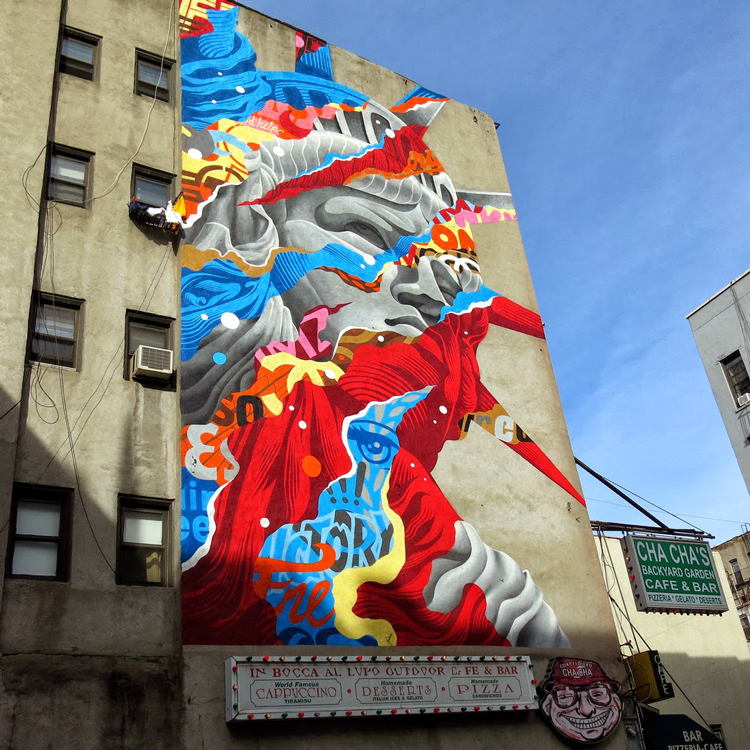
The Liberty mural in Little Italy. Photos: streetartnews.com
What’s your process like for making art in large scale?
It changes all the time. Sometimes I project and trace what I need or freehand what I need. The times I project are when the scale is insurmountable or there’s a time factor. I don’t use any stencils or tape, I only freehand. That’s sort of an homage to graffiti and the old-fashioned way of doing things.
Projection is a great tool, but it can be a crutch. I know there are artists that do it and won’t tell you that they do. I think it’s fine to do it as long as you know how to do the same without it. Every once in a while I’ll do something free-hand just to prove a point. [Laughs]
How do you mentally and physically prepare?
It’s completely different depending on whether I paint alone or with a team. I have some great fucking people that I paint with. Richie Henderson and Shane Jessup. Those are my favorite guys to paint with. The nature of my work allows for a support team. When I work with them, we can get started with a shot of whiskey and a high five to get pumped. It’s a great time doing it together.
When I paint alone I’m up [at] 6 AM, I have lunch on the lift, and I basically stay up until the sun comes down. It seems crazy, but I’ve actually painted stuff faster alone than with help. When I paint with assistants I have to make sure that they eat, that I’m not overworking them. When I’m alone, who gives a shit about food or sleep?
Do you prefer painting alone or with your team?
I love the brotherhood and I also love the solitude. In both cases it’s always an intimidating, long, dangerous, large task. It’s exhilarating either way. It’s also nice to share that with friends who witness the overcoming.
How has graffiti influenced your art?
For me, a graffiti artist was someone who painted their name on trains or around the city in a passionate way that coveted respect from the streets. They are some of the last outlaws in a world full of strip malls, credit cards, and stuff.
I will infinitely respect the hardcore graffiti artist, especially the ones that I call my friends. I was never a “letters” guy. I was more into characters and into it for the love of the art. But in the back of my mind, I knew that some writers respected my characters, so I knew that it was doing something. The street artists that I love the most have also come from a graffiti background.
“[Graffiti artists] are some of the last outlaws.”
I am really lucky to know a lot of the old-school graffiti writers that were like big brothers to me, Dr. Revolt especially. He introduced me to a lot of other guys in the RTW crew, like Quik and Zephyr. NYC Lase introduced me to Futura, Stash, Espo, SP-One and Tats Cru. I also got to know Haze, Maze, and Seen back then.
Can you explain the union or divide between street art and graffiti?
There’s a disconnect with street art when artists don’t know anything about graffiti rules. Sometimes I’ll see a wheat pasting over a nice burner and just think, “Oh my god!” That can get you popped or hurt. That kind of naive part of street art bugs me.
How would you explain your current focus and style of work?
The last few years of my work has come from big changes in my life where I’ve shut down my studio and other projects of mine in order to focus 100 percent on my fine art. It’s forced me to simultaneously consolidate a lot of visual aesthetics that I’ve been working with. They are all equal but different, and I had to find a way to force them together. This is what led me to a collage of all of these together. That’s what’s birthed this style. I’ve been developing and playing with that and it’s been very liberating.
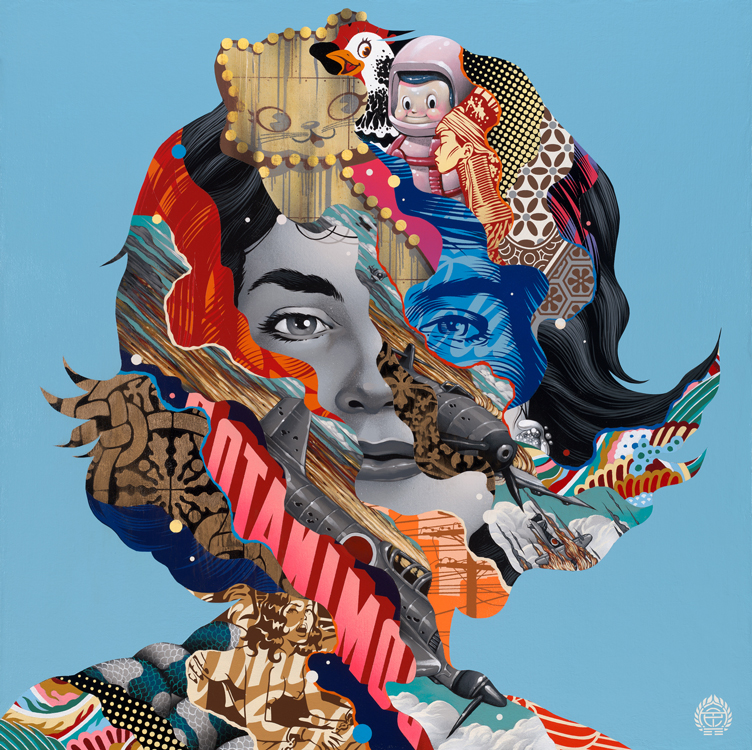
“Dominator,” 2014. Acrylic, spray paint.
What was it like to recently leave New York to return to Los Angeles?
It was super humbling to move back to LA because tons of people knew my work more in New York than out there. There’s definitely a geographic divide in terms of what’s happening locally. I had done this two-man show with Seen in New York and no one out there had ever even heard of it. But it was cool to get to the West Coast and meet the MSK guys and build more friendships on that side. It’s inspiring on both sides.
You have an extensive geographical span. Can you summarize it in terms of years?
I was born in Los Angeles in ’78. I lived in London from ’85 to ’93. In Michigan from ’93 to ’98. And in New York City from ’98 to 2012.
How did living in all of those places affect your appreciation for underground or pop culture?
My brother and I surfed through global culture via the moves our family made. He’s four years older than me and grew up in Los Angeles at the beginning of skateboarding culture. Back then it was all about Bones Brigade and Vision, and skating off of launch ramps.
Then in London ’85 it was the beginning of skateboarding there. I got into comic books and graffiti then. When we moved to Michigan I was starved from a lot of that because there wasn’t much access to it.
“[Detroit is] where I got my first taste of figuring out how to make a living as an artist while giving tribute to all of the cultures that I loved.”
Tell me about the time you spent in Detroit.
When I finally got my license and was able to move to downtown Detroit, it was a playground. It was lawless and completely open. We could explore abandoned buildings on acid and paint shit, break shit. It was a dream. My brother worked at a Kinkos there and every rave in the city printed their flyer at his store. We would go to all the biggest and dopest parties everywhere. It was awesome.
How did you begin your artistic endeavors while there?
I did two years of art school in Detroit and then took a year off to work because I had such a groove doing printing for radio stations and night clubs and bands and DJs. I was making a living just doing that. Granted, i was only paying $300 in rent. Then I forced myself into a job at this famous printing spot called the Highway Press. They were legendary and printed for some pretty famous names like Gary Grimshaw, Mark Arminksi, Stanley Mouse, and Derek Hess. That’s where I got my first taste of figuring out how to make a living as an artist while giving tribute to all of the cultures that I loved.
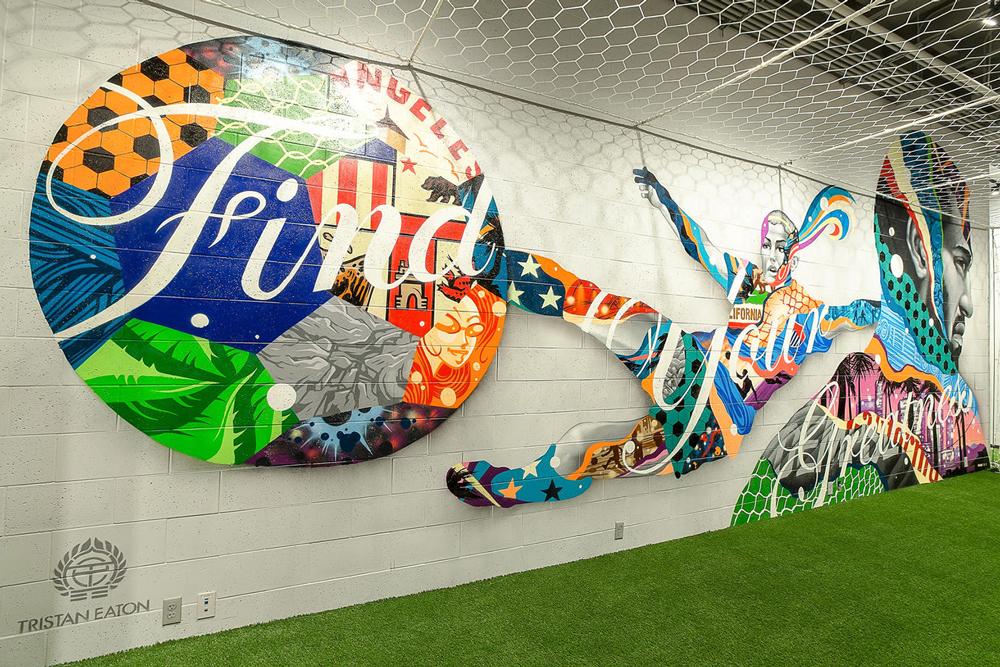
Photo: hypebeast.com
What was it like living in New York City?
When I moved to New York, I tried to finish my degree at the School of Visual Arts. I did a year and then dropped out again to work. I was emboldened by my success in Detroit, so I thought I could freelance in New York. I went through four years of hell before things got better.
A lot of people that are doing dope shit now where there then with me. Rate, Mint and Serf, and Esao Andrews, they were all super young. There was also a gallery called Subculture Gallery in Little Italy that I was a part of. It was like a men’s club, social club, gallery where about 40 artists would show every month and split the work 40 ways. Those same people that ran that, Erik Foss and Dave Schwartz, wound up shutting it down and opening Lit Lounge. That was my connection to East Village and Lower East Side life.
Tell me about starting Thunderdog Studios and your creative endeavors there.
Thunderdog was born from my exit from Kidrobot. I felt like I had I done a lot in my life that wasn’t just designing and I wanted to continue to explore a variety of creative outlets. I was painting motorcycles, designing rock posters, doing editorial illustrations for magazines like FADER and Rolling Stone. I felt like I wanted freedom projects. I was able to get help from the agency that’s represented me for over 17 years and still to this day, to help me manage clients and what not. I wanted to get out of being broke and start developing bigger creative projects and of my own creation. I created Thunderdog with Filth and Superdeux to be the creative backbone of all of that.
I started in DUMBO then went to Long Island City, then Williamsburg, now Los Angeles. We’ve worked with everyone from Barack Obama to Nike to Disney on creative art projects that gave us lane. It was amazing to have them come to us for advice and allow us to carry out things in our way. At its biggest it was 12 people. At its height we were doing a lot, but it was more managing personalities than me doing art. Most of the day was spent on logistics.
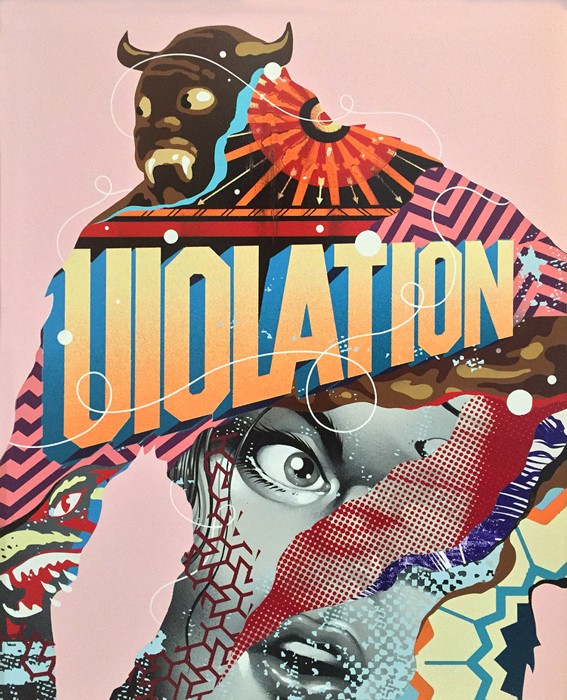
“Violation,” 2015. Acrylic, spray paint.
What made you step away from Thunderdog to pursue your personal art again?
I felt it in my gut. I enjoyed the challenges of big rebranding campaigns for clients like Rockstar Games, but I knew it wasn’t what I wanted to do ultimately. Eventually I just didn’t care as much and became weary, so I quickly closed up shop. Those creative skills I’ll have with me forever though.
One of my assistants is kicking ass with Shepard Fairey now. Another went back to New York and I just started painting again. That’s how the Liberty Mural happened. I did that on my own. I got 16 people to give me $500 bucks each, and in exchange, I put their names in a plaque on the wall. That was one of the first of dominos of walls. Sometimes you can’t ignore what you feel inside. I felt the time was right to go back developing my own personal work.
“You really have to pay attention to who you are. That leads to honesty about what you’re doing.”
Your journey has literally come full circle, what are the biggest lessons that you feel have applied throughout it all?
A common thread through all of it, from being in the boardroom to being in the street painting graffiti to painting canvases, is that all of it requires you to know yourself. You really have to pay attention to who you are. That leads to honesty about what you’re doing. Doing work that you feel is good and never trying to cut corners and working as hard as you need to in order to do the best possible work. That comes with a certain amount of honesty with yourself and honesty with the people around you. Things become easier when you face the truth.
One of the scariest things that I’ve had to do is be on discussion panels or lectures. I’ve found that comes easily when you’re completely being yourself. When you’ve got nothing to prove then nothing is scary.
If not for art, what would you be doing instead?
I always said that if the art thing fails, I always said that I’d love to open a movie theater. Film is my second love. Art and travel have been my main thing really. Now I get to travel and make art, my two favorite things in the world. And if not that, just zombie films or something. [Laughs]
***

